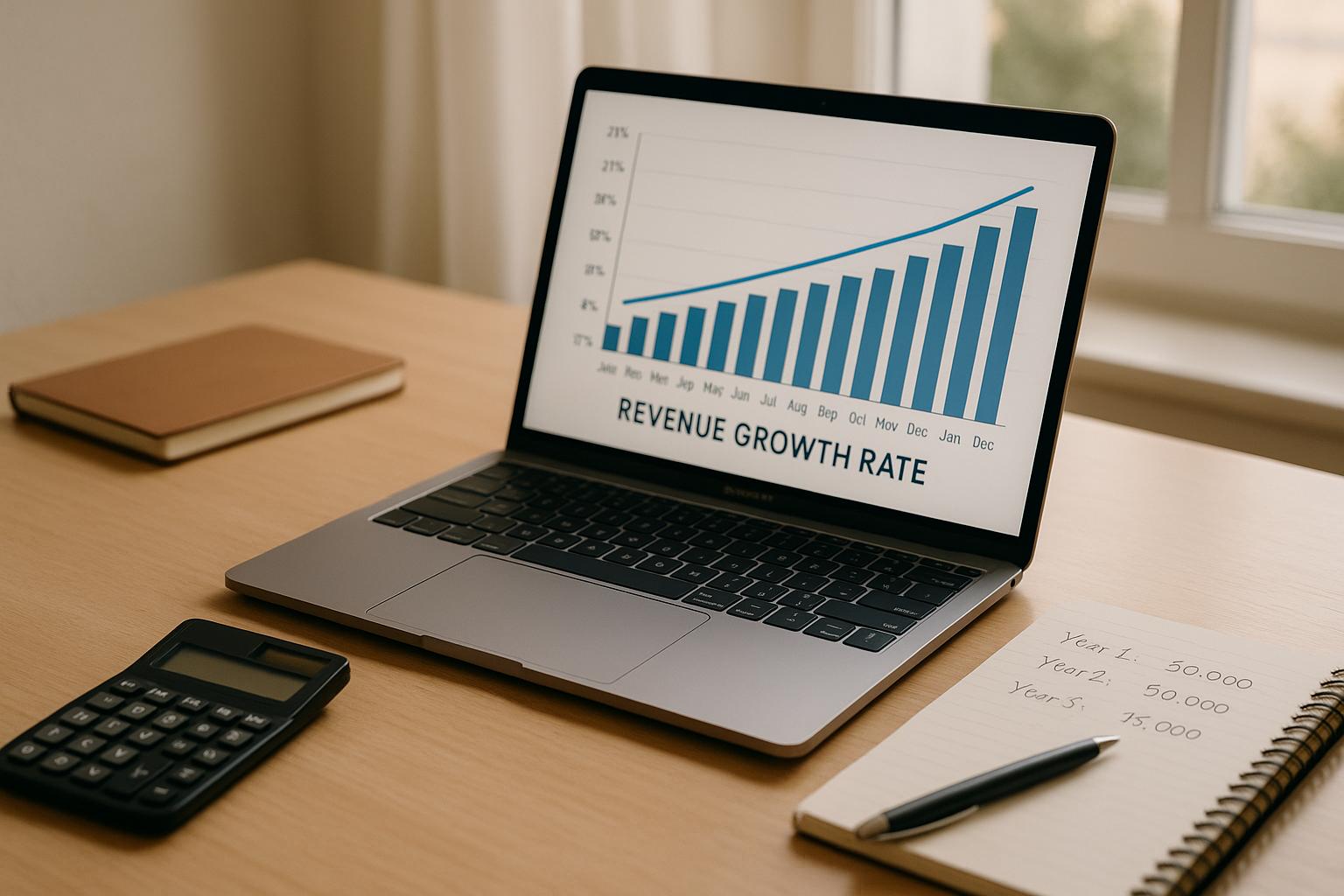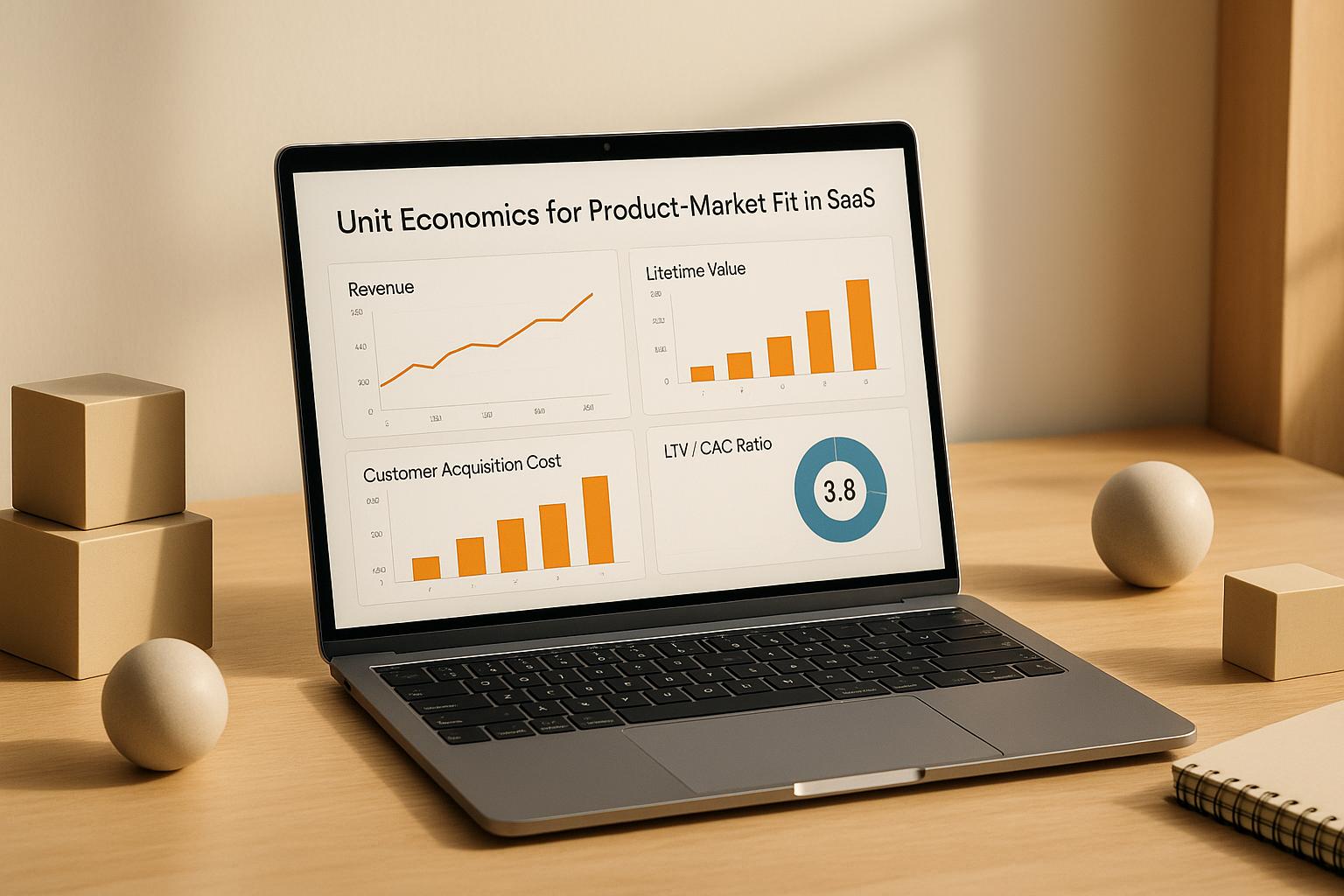Ultimate Guide to SaaS Dashboard Metrics

SaaS dashboard metrics help businesses track performance, optimize decision-making, and manage growth. They focus on key areas like revenue, customer health, and product usage. Here's a quick overview of what you’ll learn:
- Key Metrics: Monthly Recurring Revenue (MRR), Customer Acquisition Cost (CAC), Churn Rate, and Lifetime Value (LTV).
- Business Benefits: Faster decisions (40% improvement), reduced financial risks, and better operational efficiency.
- Dashboard Design Tips: Use clear visuals, role-based views, and real-time updates.
- Advanced Tools: Predictive analytics for churn, revenue forecasting, and customer insights.
Whether you're scaling your SaaS business or improving efficiency, this guide covers the essentials of building and using effective dashboards.
Main SaaS Dashboard Metrics
Tracking the right metrics is key for growth-stage SaaS companies. Here's a breakdown of the most important data points to include in your dashboard.
Financial Metrics
Financial metrics are at the heart of SaaS performance tracking. Focus on these three:
- MRR/ARR: Monitor Monthly Recurring Revenue (MRR) and Annual Recurring Revenue (ARR) to track consistent growth.
- CAC Payback Period: Use this formula: (Total Marketing Spend ÷ New ARR) × Gross Margin Percentage. This helps gauge how quickly you're recouping customer acquisition costs.
- LTV:CAC Ratio: Compare the lifetime value of a customer (LTV) to the cost of acquiring them (CAC) to assess profitability.
Customer Metrics
Financial metrics are closely tied to customer health. Keep an eye on these:
- Net Promoter Score (NPS): Monthly tracking helps identify customer loyalty. Scores of 50 or higher suggest strong customer advocacy.
- Gross Churn Rate: High churn (above 5% monthly) could point to problems with your product or customer success efforts.
- Expansion Revenue Rate: Aim for upsells and cross-sells to contribute over 30% of your ARR growth. This aligns with preparing for future funding rounds.
Product Usage Metrics
While financial and customer metrics show results, product usage data uncovers the "why" behind those results:
- Feature Adoption Rate: Track the percentage of users actively using key features.
- User Activation: Measure how many users complete onboarding milestones - this is a strong predictor of retention.
- Cohort Analysis: Segment users by signup dates to spot retention trends and patterns across different customer groups.
Dashboard Design Guidelines
Once you've identified your core metrics, the next step is designing a dashboard that places them strategically and makes them actionable for decision-making.
Design Fundamentals
The best SaaS dashboards use a clear visual hierarchy to guide users toward the most critical information. Highlight key metrics - especially those tied to scaling - by placing them prominently and using bold visuals. Group related metrics with consistent color schemes and layouts for better organization.
Dashboards should offer quick insights at a glance but also allow for deeper dives when needed. For instance, you might use color-coded sections to separate revenue data from customer metrics, making it easier to focus on specific areas.
| Dashboard Level | Key Components | Update Frequency |
|---|---|---|
| Executive | Financial Health | Daily |
| Team View | Department KPIs | Hourly |
| Detailed Analysis | Raw Data | Real-time/Batch |
Data Update Methods
Real-time updates are essential for certain metrics, like revenue alerts or system health indicators. However, for more complex calculations, a hybrid approach works best. Use real-time updates for critical data but batch process the rest overnight. This strikes a balance between dashboard speed and data accuracy.
Role-Based Dashboard Views
Role-based views build on your core metrics by adding context tailored to specific roles. Instead of creating entirely separate dashboards, use a modular design. Start with shared baseline metrics, then layer role-specific data on top.
"Properly designed dashboards decrease monthly metric review time by 65% through smart alerting and improve decision velocity by 40% via role-specific benchmark displays", according to Phoenix Strategy Group's client data.
To ensure sensitive data is secure, integrate row-level security with your SSO provider.
| Role | Primary Focus | Key Visualizations |
|---|---|---|
| Executives | Strategic Trends | Multi-period Comparisons |
| Product Teams | Usage Patterns | Funnel Analysis |
| Customer Success | Health Scores | Risk Indicators |
Data Visualization Methods
Matching Charts to Metrics
Choosing the right visualization for your data isn't just about aesthetics - it directly affects how quickly and accurately decisions are made. Here's a quick guide to pairing metrics with the most effective chart types:
| Metric | Chart Type | Use Case |
|---|---|---|
| Revenue/MRR | Line Charts | Analyze historical trends with dual axes |
| User Retention | Cohort Tables/Heatmaps | Spot patterns across different user groups |
| Feature Adoption | Bar Charts | Compare adoption rates across segments |
| Geographic Usage | Heat Maps | Visualize regional distribution |
| DAU/MAU Ratio | Gauge Charts | Get a quick snapshot of business health |
Common Visualization Errors
Mistakes in visualizations can lead to costly misinterpretations, especially for subscription-based businesses where small errors can snowball over time.
"A 3D bar chart visualization led to a 22% overestimation of MRR growth compared to standard 2D representation, highlighting how seemingly minor design choices can severely impact metric interpretation", according to a study by Phoenix Strategy Group.
Here are two common pitfalls to watch out for:
1. Temporal Data Handling
- Choosing the wrong chart type for time-series data can confuse viewers. For example, avoid pie charts for trends over time.
- Always standardize time periods when comparing related metrics, and clearly label measurement intervals.
2. Cognitive Overload
- Overloading dashboards with more than 8 metrics in a single view makes it harder for users to process the information.
- Instead, create focused views with clear hierarchies to make complex dashboards easier to navigate.
Update Frequency Guide
To keep your data actionable, align update intervals with your team's needs. High-growth SaaS companies, for instance, often update financial data daily and product usage data in near real-time.
| Metric Category | Update Frequency | Consideration |
|---|---|---|
| Active Users | Every 15 minutes | Supports real-time monitoring |
| Financial Data | Daily batches | Ideal for morning decision-making |
| Cohort Analysis | Weekly | Helps identify long-term patterns |
| Churn Indicators | Instant | Enables immediate action |
For critical metrics, use dedicated data pipelines to ensure real-time updates. Less time-sensitive data can be processed in batches during off-peak hours.
"Users should grasp key insights within 5 seconds", emphasizes Phoenix Strategy Group.
sbb-itb-e766981
Advanced Analytics Integration
Advanced analytics take dashboards beyond basic visuals, turning them into tools for smarter, data-driven decisions. Here's how:
Predictive SaaS Analytics
Machine learning uses past data to predict future trends. For example, with 12-18 months of clean data, you can achieve ±5% accuracy in forecasting Monthly Recurring Revenue (MRR).
| Predictive Model | Data Needed | Forecast Range |
|---|---|---|
| LTV Forecasting | Purchase history, engagement metrics | 12 months |
| Churn Prediction | Login frequency, support tickets | 30-60 days |
| Revenue Expansion | Feature adoption rates, account value | 90 days |
Churn Risk Analysis
Spotting churn risks early can save customers. Real-time alerts flag users with three or more risk factors, such as shorter session lengths, unpaid invoices, or lower engagement scores.
"A Health Score widget combining support interactions, contract renewal dates, and product engagement heatmaps helped reduce churn by 15% for our B2B SaaS clients."
Key risk indicators include:
- Shorter session durations
- Outstanding invoices
- Dropping engagement scores
Third-Party Tools
Predictive models are only as good as the data supporting them. To get the most out of these tools, ensure a strong data infrastructure.
Consider adding:
- Churn probability gauges
- LTV trend indicators
- MRR waterfall charts
- Heatmaps for usage patterns to time interventions effectively
Using custom KPIs compared to industry benchmarks helps track critical metrics like retention, all while keeping growth in focus.
Main Takeaways
SaaS dashboards revolve around three key data types: financial metrics, customer health indicators, and product engagement trends. Metrics like MRR (Monthly Recurring Revenue), ARR (Annual Recurring Revenue), Customer Lifetime Value (CLV), churn rates, and engagement ratios such as DAU/MAU are the backbone of a well-designed dashboard.
The success of a dashboard depends on smart design choices. Keeping widgets limited to the essentials avoids clutter and ensures insights remain actionable. Real-time updates are especially impactful - UXCam found that teams using automated alerts respond to churn risks 23% faster.
Implementation Steps
Building an effective SaaS metrics dashboard involves a clear, three-step process:
-
Evaluate Your Data Systems
Start by auditing your CRM and payment integrations. Identify 5-7 KPIs tailored to each department, ensuring you're tracking the most relevant data from the start. -
Train Teams Based on Roles
Conduct role-specific workshops to encourage adoption and consistent usage across teams. -
Set Up Ongoing Maintenance
Schedule quarterly reviews of your metrics and rebuild your dashboard annually to keep it aligned with evolving goals.
Companies like Phoenix Strategy Group have shown how structured approaches can streamline this process. For example, their three-phase model helps align metrics with funding stages, enabling 25% faster metric standardization during Series A growth.
FAQs
Here, we tackle some common questions about the metrics and design principles discussed earlier.
What are the key metrics for a SaaS business?
Key metrics that influence growth and long-term success in SaaS include Customer Acquisition Cost (CAC), Monthly Recurring Revenue (MRR), Churn Rate, Customer Lifetime Value (LTV), and Activation Rate. For companies in their growth stage, Months to Recover CAC and Lead Conversion Rate are particularly important. According to Phoenix Strategy Group, these metrics are crucial for understanding how efficiently a business uses capital during scaling.
Each metric tells a specific story:
- CAC: Measures marketing efficiency.
- MRR: Tracks recurring revenue.
- LTV:CAC: Indicates profitability.
- Lead Conversion Rate: Highlights sales performance.
What are SaaS dashboards?
SaaS dashboards are visual tools designed to display real-time data on key performance indicators (KPIs). They provide insights into areas like:
- Financial performance
- User engagement
- Customer retention
Phoenix Strategy Group uses a three-tier dashboard system tailored to different roles within a company.
In one case study, their dashboard improvements helped a Series B company cut its monthly reporting time from 45 hours to under 3 hours.
This streamlined approach aligns with the earlier steps for effective implementation.




